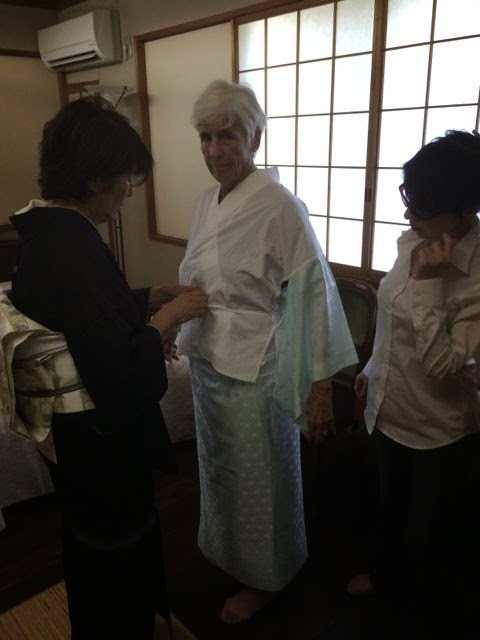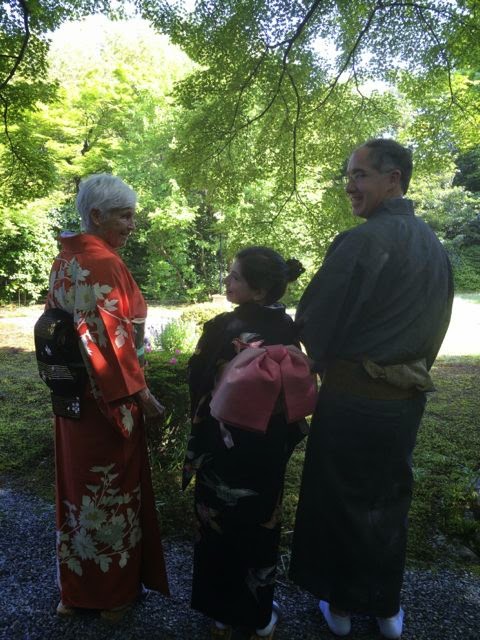On our final day in glorious Japan, we felt its soul.
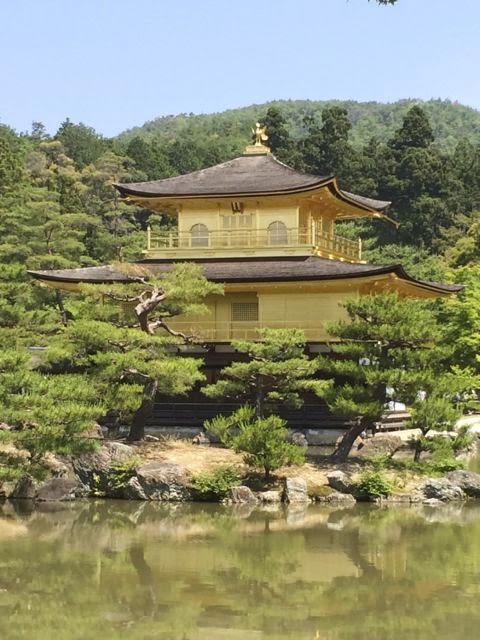 |
| Golden Pavilion |
Early in the morning I found a quaint Anglican church and was able to worship with about 25 communicants in a relaxed service where the sermon is a discussion of the readings with congregation chipping in. The welcome was kindly as it has been everywhere I’ve been in this country.
Already sun was bright, the air sweating as we joined masses of young people at the Zen Buddhist Temple of the Golden Pavilion set in an enormous Japanese garden winding around a mirror pond called Kyokochi and representing the pure land of Buddha in this world. People swarm here in April for the cherry blossoms and in the fall for the changing of the colors of leaves. The pavilion, referred to as the retirement home of the Shogun of Asihikaga, was built in 14th century and is at the bottom of a mountain side on which a huge Chinese character for “Big” is carved. To keep the form, each year there is a massive bonfire on August 16th that honors the spirits of the deceased. After locals entertain their ancestors (like day of the dead) with meals and dancing, the bonfire is lit to light the way for the deceased ancestors return to the heavens.
 This Shogun didn’t like wars and fighting but was an aristocrat and into the arts, founding the first of the Noh Dramas which were exchanges between the living world and the spiritual world with many actors in masks of ghosts. He abdicated his Shogun role at age 39 to live in this
This Shogun didn’t like wars and fighting but was an aristocrat and into the arts, founding the first of the Noh Dramas which were exchanges between the living world and the spiritual world with many actors in masks of ghosts. He abdicated his Shogun role at age 39 to live in this
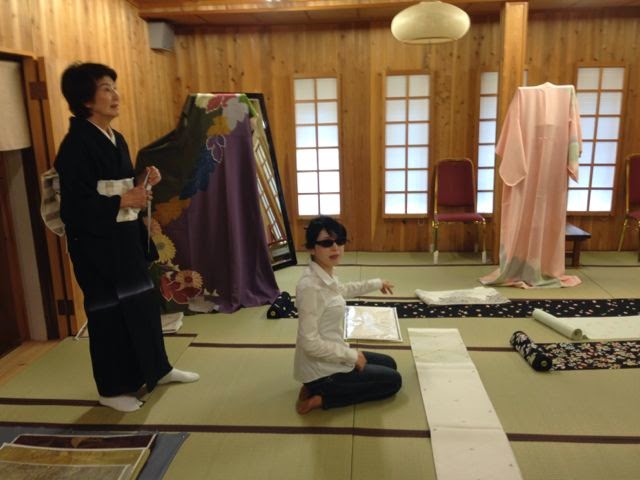 |
| Kimono studio |
peaceful setting as an aristocrat rather than a warrior. He designed the Pavilion with three levels: The bottom layer is in the shindin style,plain and simple out of the dark brown wood, to honor the Emperor and aristocracy; the second level in the buke style of the warrior, and third floor is in the Zenshu-butsusen style temple. On top of the shingle roof is a golden phoenix. This temple is also popular for the tragic story of a young boy who felt lost in the world and loved the Golden Pavilion as a friend, and wanted to die with “him” so set fire to the Pavilion, although the boy was convinced by the Pavilion not to commit suicide.
We had the special privilege of visiting a hand-woven textile shop, Orinasu-Kan, where the most elegant kimonos are created. We saw the weaving process on the very old looms, but still using computer cards to guide their designs. It takes about a month to complete the weaving of fabric for one Kimono. The owner graciously showed us the basics and invited us to her elegant home in the Northern part of the city in the mountains where we had the honor of learning how to prepare the special tea ceremony.
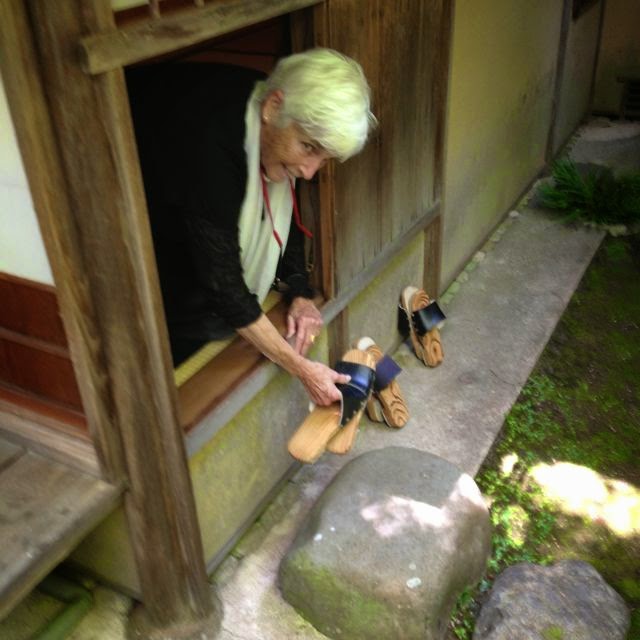 |
| tea house entrance |
It is special to have a tea house and we walked there in the wooden sandals (not easy) being careful to only step on the stones (surrounded by bright green moss) that took us through her magnificent garden to the entrance. First we washed our hands by pouring water from the holy fountain with a cup with a long stem as we had done at various temples. Then we were asked to enter through a very small square door on our knees, leaving the shoes outside, and going through a certain ritual. This tiny entrance was made because Samurai warriors wore so much gear and swords that they needed to leave that outside to enter into the tea house.
 |
| sweet |
Green tea was brought to Japan from China and the ceremony is an example of the simplest form of minimalism, balance and composure. Each piece of the tea has a place and a meaning. Nothing is left to chance. Each piece is cleansed in front of our eyes before the ceremony starts. Before the tea is served, we were presented with a single moist sweet (pounded from rice and bean paste) and tiny dry sweets in the shape of a maple leaf (the garden) and a bowl of water. This stops the bitterness of the green tea. The tea has been grounded into powder in mortal and pestle and is the Miche tea. Then the hostess, having prepared for the ceremony while we ate the sweets, having checked the water was the right temperature in the double pottery pot, and with a tiny scoop (about a quarter of an inch wide) places two helpings of
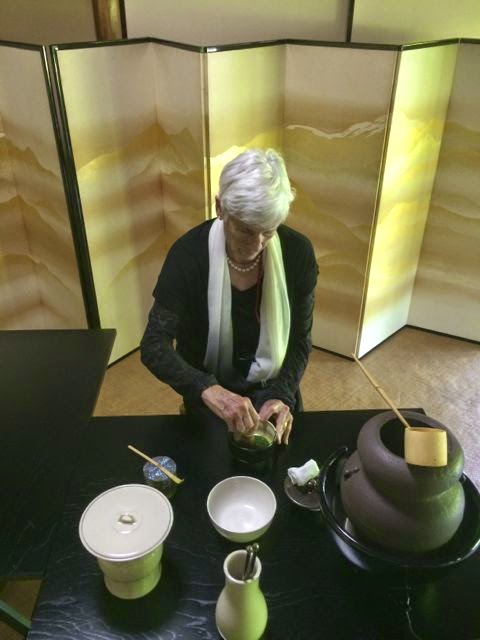 |
| Tea ceremony |
green tea powder into the bowl (like a miso soup bowl). Then with a wooden scoop with a long handle she takes a half cup of hot water and pours onto the powder. With a tiny bamboo whisk, strategically placed, she began to beat the tea, moving forward and backward quickly until a green foam appears. Then the tea is ready. There is no sugar (you had the sweets already) and the bowl is the tea cup. Then placing the cup in the left hand, and balancing with the right, you place the bowl in front of your guest with the front of the bowl (with the most design) facing the guest. You bow. The guest then accepts the bowl and turns it clockwise two times so she will not put her mouth on the splendid design. Using both hands, the bowl of tea is consumed. I was amazed at how tasty the green tea was, not at all bitter. Both Caroline and I had a chance to do the tea making process, which is quite an honor.
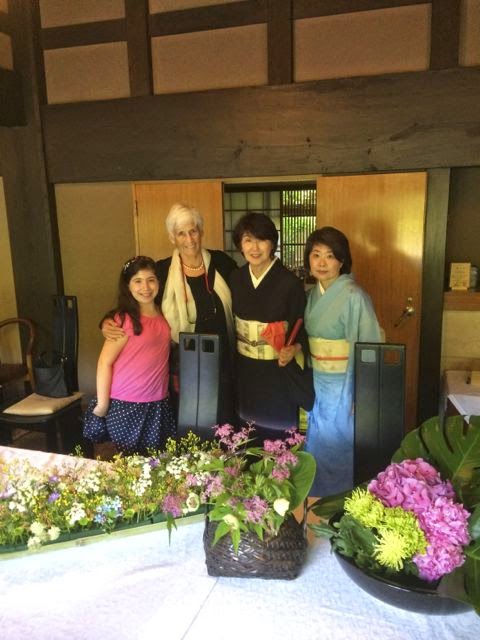 |
| Flower designers |
 |
| Ikebana class |
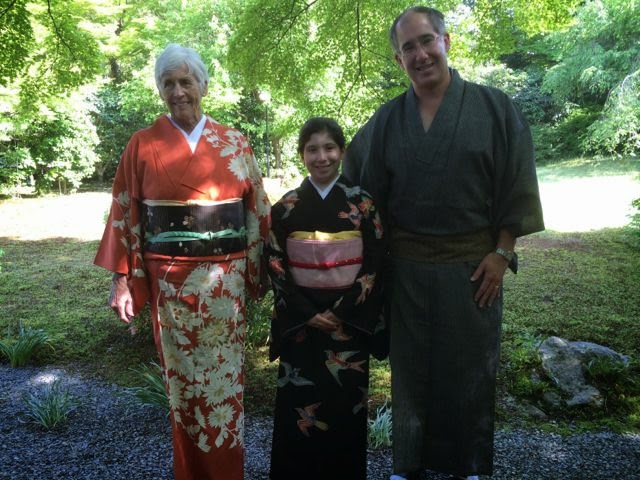 |
| Kimonos in tact
|
The wrapping of the obi is the most complicated and takes a couple of helpers to get it tight and correct. But the end result can turn a urchin into a princess. Men’s kimonos are less complicated but just as meaningful. When we were all put together, it was down to the garden to be photographed. I loved the feel of the tight obi which supports the back. I will never know, however, how these super women can bend and kneel and move
so quickly while wearing these complicated but spectacular ceremonial robes. It was an honor for all three of us.
After the “dress up”, the hostess took us into a special room where there were buckets of flowers and enormous Ikebana vases. We were to learn the principles of Ikebana. It’s been a few years since I have done flower designs, although it was my passion for so long in Uruguay and in the garden clubs. I was reluctant, thinking I had lost the touch. But it didn’t take long, seeing the giant hydrangeas, the peonies, and the green baby chrysanthemums, and Easter lilies, before we were all securing stems into oasis or holders. A rewarding moment to be artistic. (James watched.)
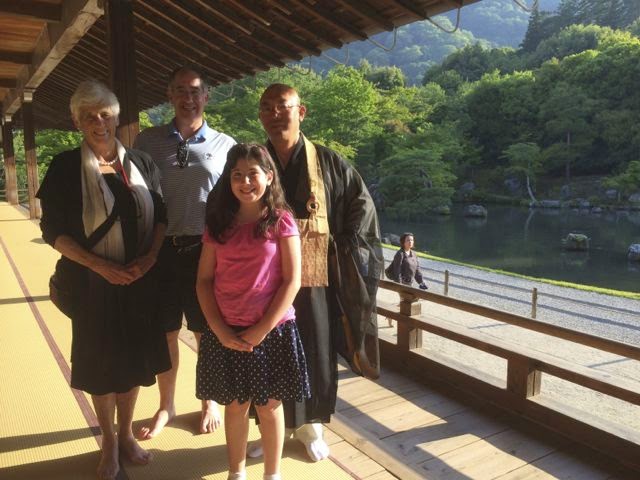 |
| with the Zen monk |
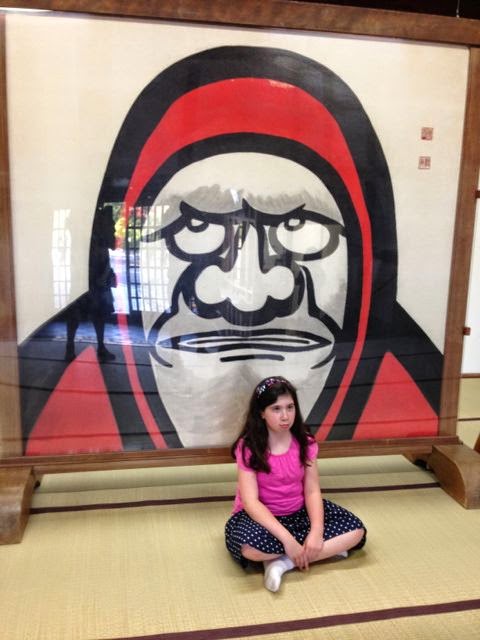 |
| sad to leave |
This afternoon was probably the most special moment of our trip. And then to top it off, we were escorted by our super guide Akiko to Tenryii-ji Temple to meet a Zen Buddhist monk/priest. This is the temple of the Heavenly Dragon and it is a site meditators seek for here the priests do labor by day and meditate from 5 p.m. til 11 p.m. in the silence of the sky, stars and moon. This 9th century temple was the first in Japan. It has been ravaged by fire eight times, and been restored. But the gardens are from the original. The priest, Osho-sama, was a friendly man dressed in a sheer black robe with a gold bib. He immediately made us feel at home, taking us to a place where we could sit in chairs and not have to sit on the floor (thank you, God), for a wonderful conversation. He emphasized how important it is to appreciate your parents and never put them aside. He explained the gardens were stimulants for meditation, which is a slow-down in daily life. “If you run seven times, you have to stop,” he said (Akiko translated). Stopping is also important.” When you are in the dark, you need to pay attention to what is around you – sounds, smells, sensations. Take time to feel the world. We are so busy running around, it is important to stop and focus on what is around you in this world. Go out and breath the air. Don’t be afraid to stop what you are doing. It’s easy to quit, he said. Continue to take time every day, regularly. Practice makes perfect. There is no short cut for life. When the monks eat together, he explained, they concentrate on the sounds and don’t speak. It’s a training process and each training has meaning. Some do it quickly. Some take time. He explained there are two types of meditation: Sotozen, which is trying to completely empty self from thought; and ring-i-san, when the master gives them a quantrum, something to think about for the day so they can discuss in the morning. There are many ways, he said. So if one does not work, go another way. When you find a good way to do things, make this your way and continue doing it. There is no correct or incorrect answer to life. It is one time for all. Find the answers for you. If you blame yourself for suffering, that’s ok because there is growth.
We were awed by what we had just heard because it related to all of us. As we left the temple, the summer heat began to wane. This had been an incredible day. Tomorrow is back on the train to Tokyo and to the airport to return to our homes. God has blessed us and I hope he has blessed you as well.
 This Shogun didn’t like wars and fighting but was an aristocrat and into the arts, founding the first of the Noh Dramas which were exchanges between the living world and the spiritual world with many actors in masks of ghosts. He abdicated his Shogun role at age 39 to live in this
This Shogun didn’t like wars and fighting but was an aristocrat and into the arts, founding the first of the Noh Dramas which were exchanges between the living world and the spiritual world with many actors in masks of ghosts. He abdicated his Shogun role at age 39 to live in this



